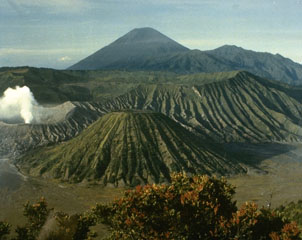Report on Tengger Caldera (Indonesia) — 2 February-8 February 2011
Smithsonian Institution / US Geological Survey
Weekly Volcanic Activity Report, 2 February-8 February 2011
Managing Editor: Sally Sennert.
Please cite this report as:
Global Volcanism Program, 2011. Report on Tengger Caldera (Indonesia) (Sennert, S, ed.). Weekly Volcanic Activity Report, 2 February-8 February 2011. Smithsonian Institution and US Geological Survey.
Tengger Caldera
Indonesia
7.942°S, 112.95°E; summit elev. 2329 m
All times are local (unless otherwise noted)
CVGHM reported that on 5 February volcanic bombs ejected from Tengger Caldera's Bromo cone were found 1.2-1.4 km from the crater rim. During 5-8 February gray-to-brown ash plumes rose 400-800 m above the crater and drifted ENE. Incandescent material was ejected 200-300 m above the crater and landed as far as 500 m away. Roaring and booming noises were noted. Ash fell at the Bromo observation post, and in nearby villages including Ngadirejo (10 km WNW), Sukapura (14 km NE), and Sumber (18 km E). High-amplitude seismicity and volcanic tremor were detected. Deformation measurements had remained stable since 31 December 2010. The Alert Level remained at 3 (on a scale of 1-4). Residents and tourists were not permitted within a 2-km-radius of the active crater.
Geological Summary. The 16-km-wide Tengger caldera is located at the northern end of a volcanic massif extending from Semeru volcano. The massive volcanic complex dates back to about 820,000 years ago and consists of five overlapping stratovolcanoes, each truncated by a caldera. Lava domes, pyroclastic cones, and a maar occupy the flanks of the massif. The Ngadisari caldera at the NE end of the complex formed about 150,000 years ago and is now drained through the Sapikerep valley. The most recent of the calderas is the 9 x 10 km wide Sandsea caldera at the SW end of the complex, which formed incrementally during the late Pleistocene and early Holocene. An overlapping cluster of post-caldera cones was constructed on the floor of the Sandsea caldera within the past several thousand years. The youngest of these is Bromo, one of Java's most active and most frequently visited volcanoes.
Source: Pusat Vulkanologi dan Mitigasi Bencana Geologi (PVMBG, also known as CVGHM)

